
This article was originally published on August 17, 2021 on The Restless Viking website.
Traveling by our zodiac, Thor, Da Viking and I headed to Lime Island for a caper. There are only footpaths on this two and half mile long island in the St. Mary’s Seaway. It lies along the shipping lane connecting Lake Huron to Lake Superior. The 980 acre island holds an interesting and long history including natives, lime kilns, then French explorers and a ship refueling community. Join us on our adventure!
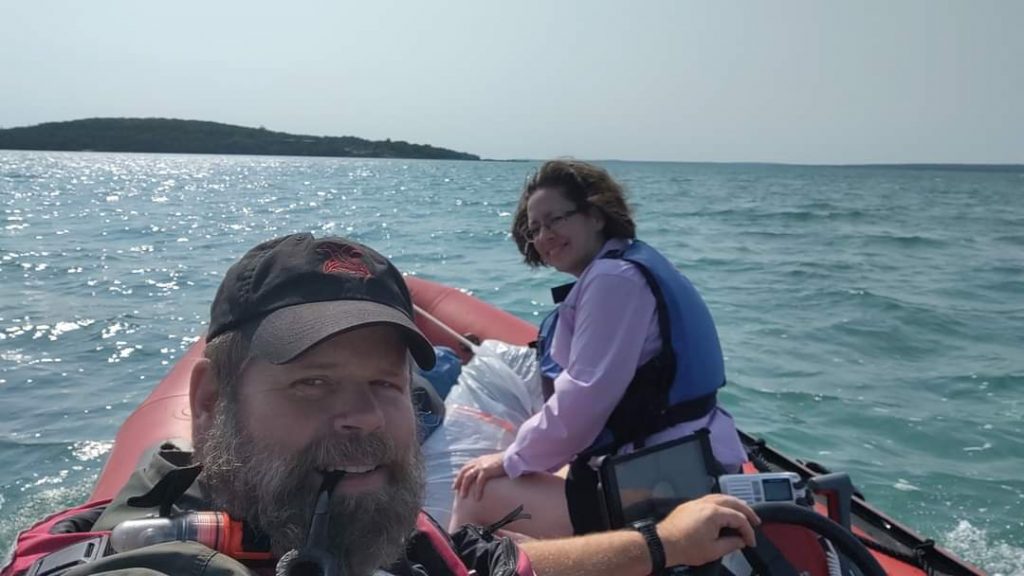
The wind danced through my hair as we embarked on the three mile crossing of the St. Mary’s River.
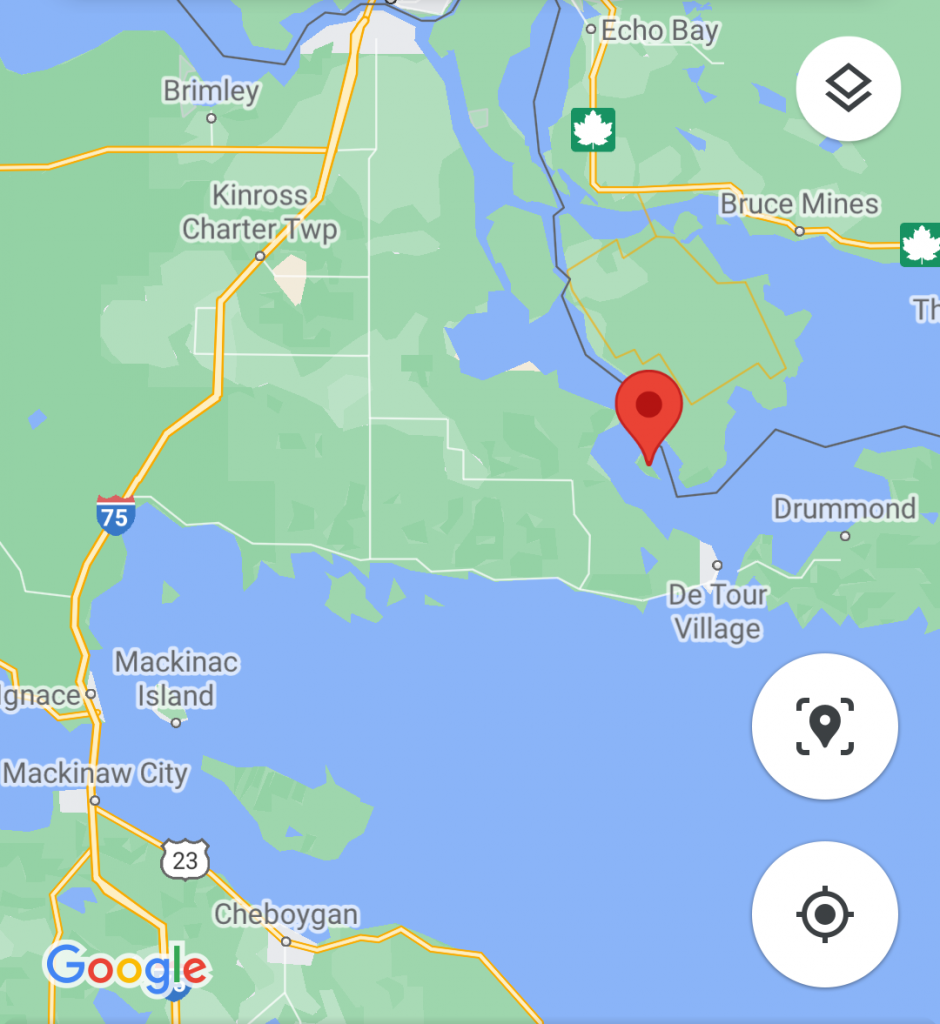
Lime Island has a curious, diverse history. It is now a state park.
Ojbwe History
Lime Island served as a meeting place for native tribes. With it’s centralized location, Ojbwe tribes from the area could paddle to the island for gatherings. Flint artifacts were found on the highest point giving evidence of human inhabitants that dated back 6,000 years. The cohorts would conduct meetings and play a game similar to lacrosse. They used this ground for burials, too.
I marveled at how the natives survived in this climate for centuries. The idea of traveling to Lime Island with bark canoes knocked my swim socks off as I relaxed in our motorized boat.
St. Mary’s River
The St. Mary’s River is three miles wide. The waves can suddenly become wicked , especially when traveling in a small boat. We were fortunate that it was an exquisite day for traversing this waterway! (For perspective, the Mississippi’s shipping channel is two miles wide.)
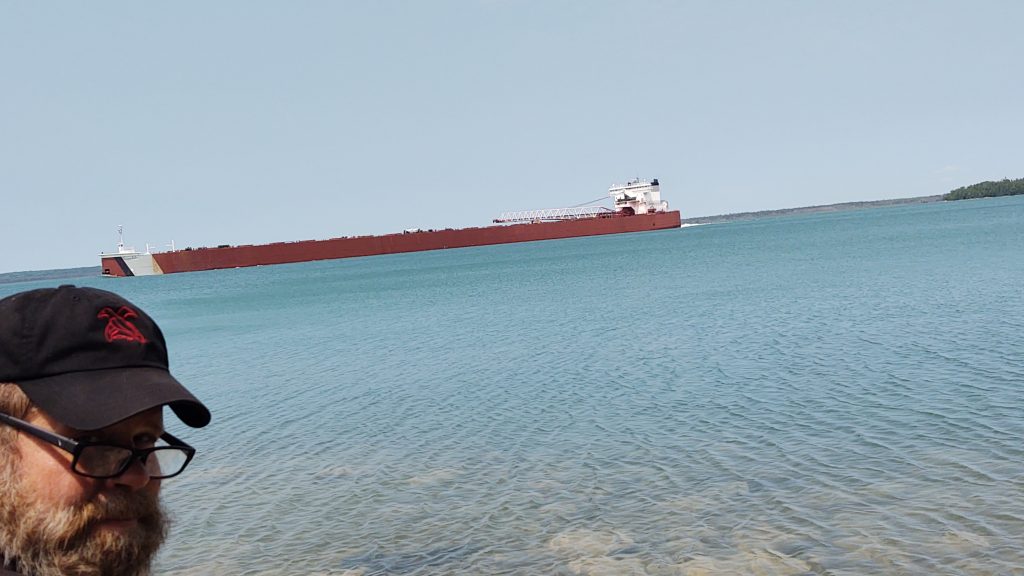
As we motored toward the island I thought about the French voyagers and missionaries who had inhabited the island in the 1700’s. They had PADDLED this distance as the natives had. “Shoot! I’ve only sat here in the fresh air and I’m tuckered out!” I thought, “These explorers had a tenacity that I’ll never grasp.”
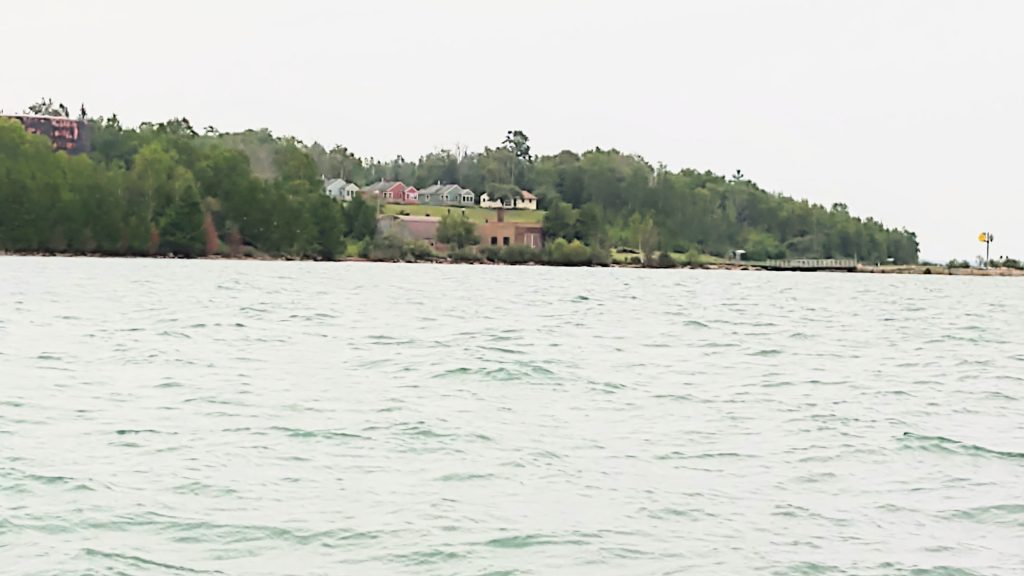
As we approached Lime Island we could see the red cabin. We’d rented the same cabin when our kids were much younger. It was nostalgic for me to return to Lime Island.
Our Arrival
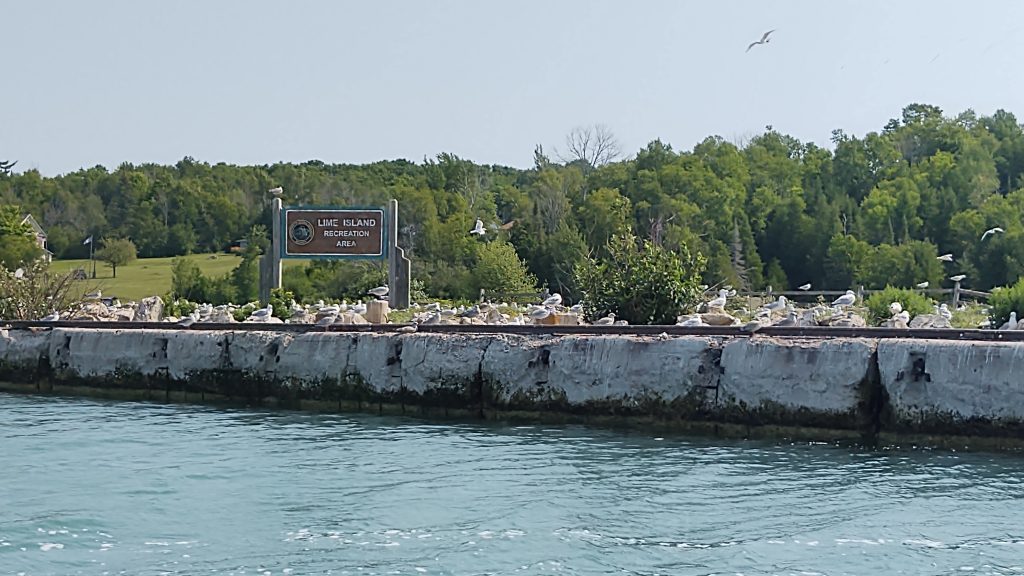
The southern portion of the old coal loading dock now serves as a protected nesting area for terns. The seagulls have insisted upon themselves and raided the party. Both species were trying to outdo the other with their constant banter.
As we motored around the break wall, we passed the squawking seagulls and terns to find the boat slips in a rumpled heap near the shore.
Da Viking improvised and casually guided Thor to two cleats for a secure tie up. He’s always calm in any adverse situation!
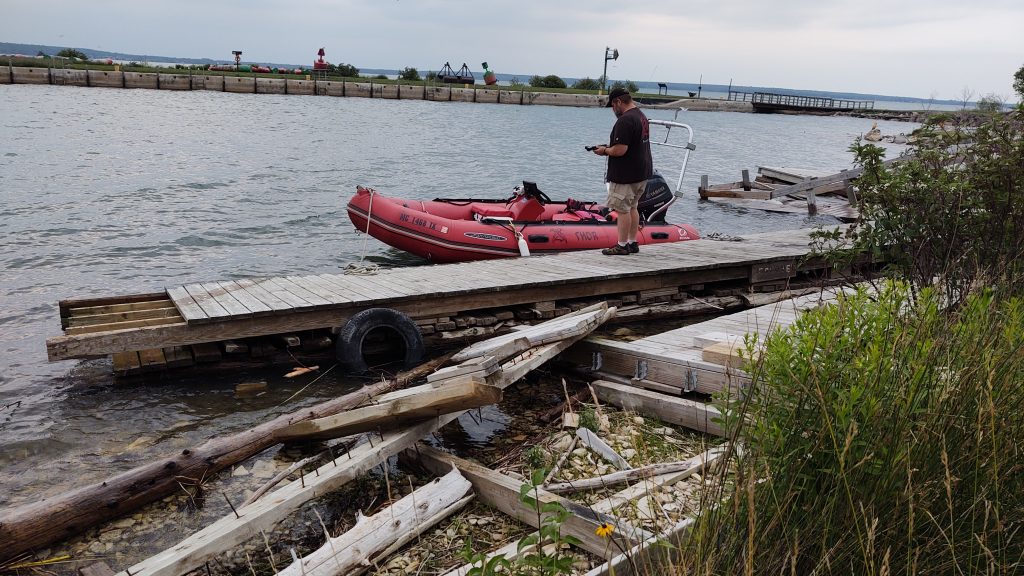
The high water had destroyed many of the once “L-shaped” slips.
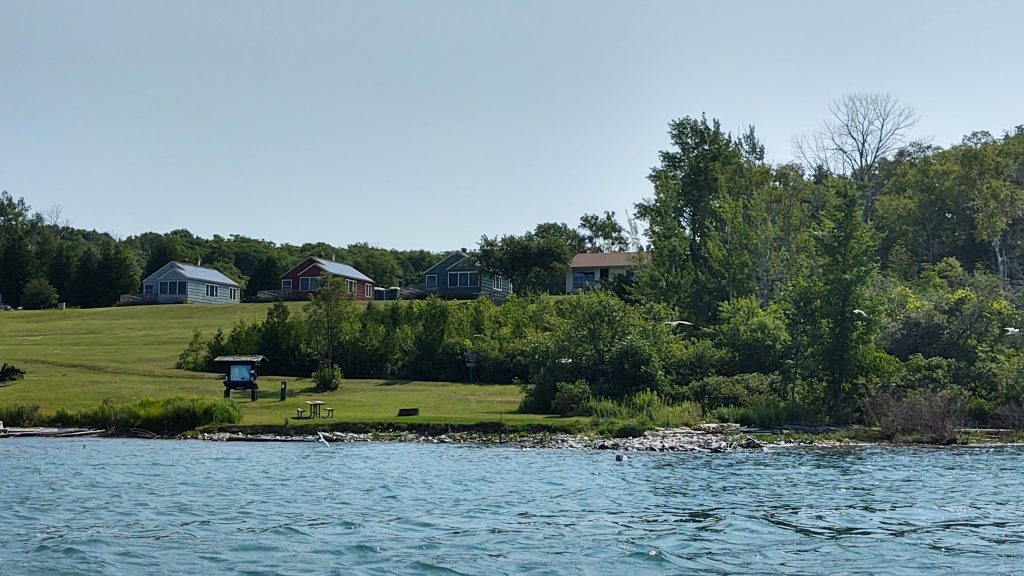
Jennifer, the July caretaker, greeted us at the shore and told us that we could leave our gear at the bottom of the hill. She said her husband, Sheldon, would bring it up in his Gator, an off-road golf-cart vehicle.
Climbing this hill from our boat took a lot more effort than I’d remembered. In fact, in the video, Da Viking had to speed up the clip which provided an illusion that I was in much better shape than the reality. Haha!
The Red Cabin
The memories of Charlotte and Noah playing cards and doing puzzles brought a smile as we entered the “red cavin” as Noah had called it.
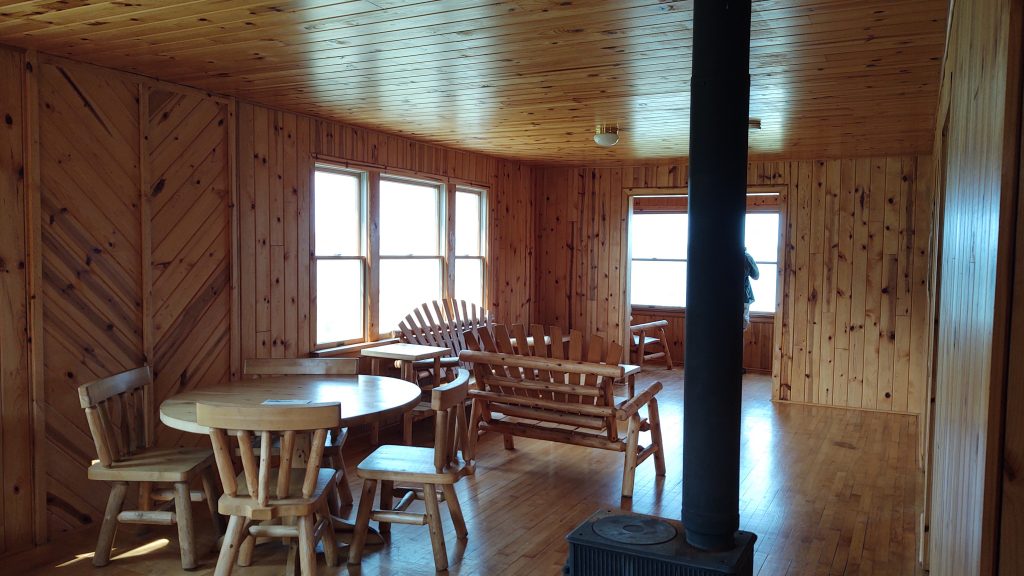
The stunning interior along with the cedar furniture was remodeled in 1996.
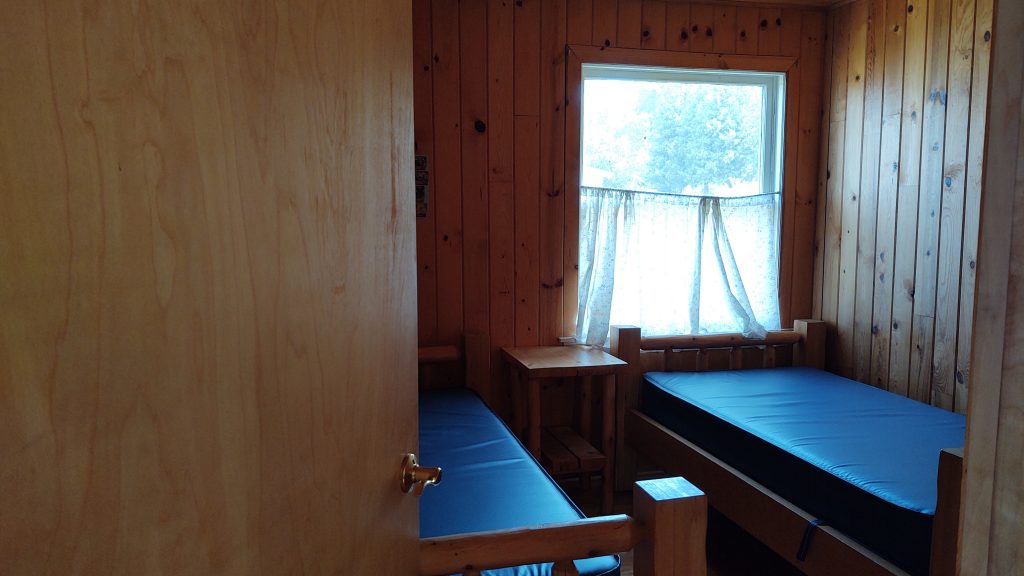
Our cabin had two beds in both of the bedrooms. We had brought fitted sheets and sleeping bags. Dry bags had kept our gear from getting splashed in our open boat.
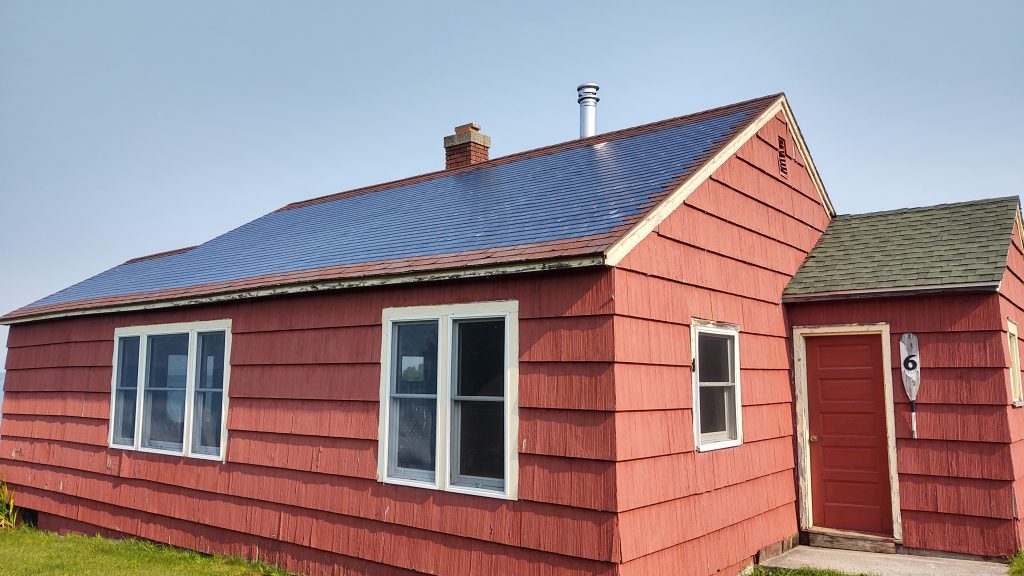
Solar power shingles were added in 1998.
Cabin amenities include solar power lighting and one outlet above the counter top. This long counter across the back wall can be used for food prep. Unfortunately we had forgotten our camp stove so we had cold oatmeal, fresh-from-the-can Spaghettios and cold soup.
We could have used the fire rings with firewood situated by each cabin, but we were low-effort and cautious. (There are warnings to only have fires in these designated spots. With coal scattered all over the island from coal refueling days, a campfire could quickly get out of control.)
Two port-a-johns stood at attention behind the cabins for residents. There’s another near the shoreline for campers who set up on the boardwalk platforms.
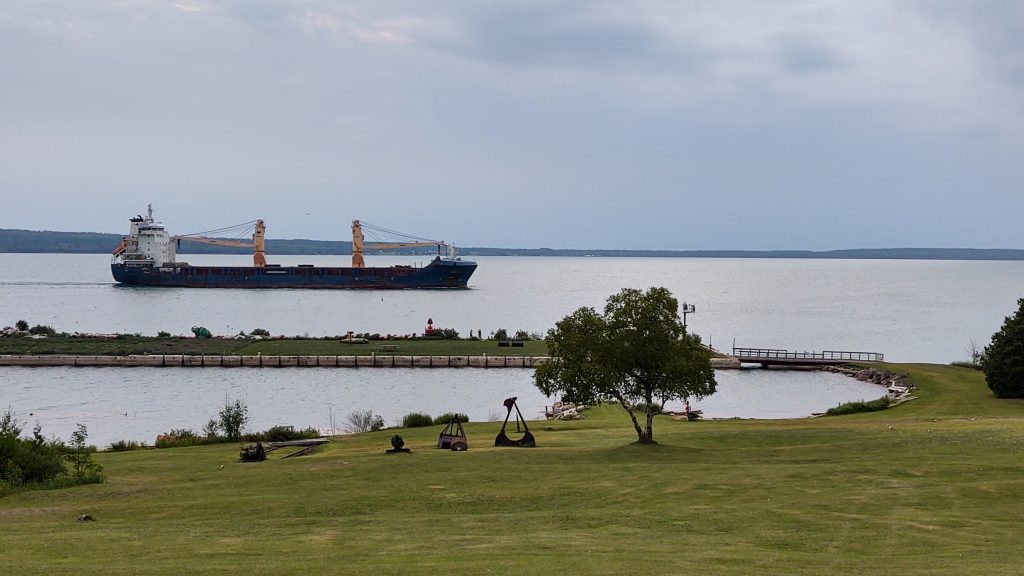
As I was fitting the sheets on our beds, this freighter whispered over the calm waters. The parade of vessels was a treat all weekend!
When planning your visit be sure to bring your own garbage bags as it’s the campers’ responsibility to carry out their own refuse.
Lime Kilns
Did you know that Lime Island, “Isle du Plastre,” appeared on a 1744 map in Paris? Lime Island had been noted in Charlevoix’s Journal d’un Voyage L’Americque. Lime is a key ingredient in making sturdy cement mortar.
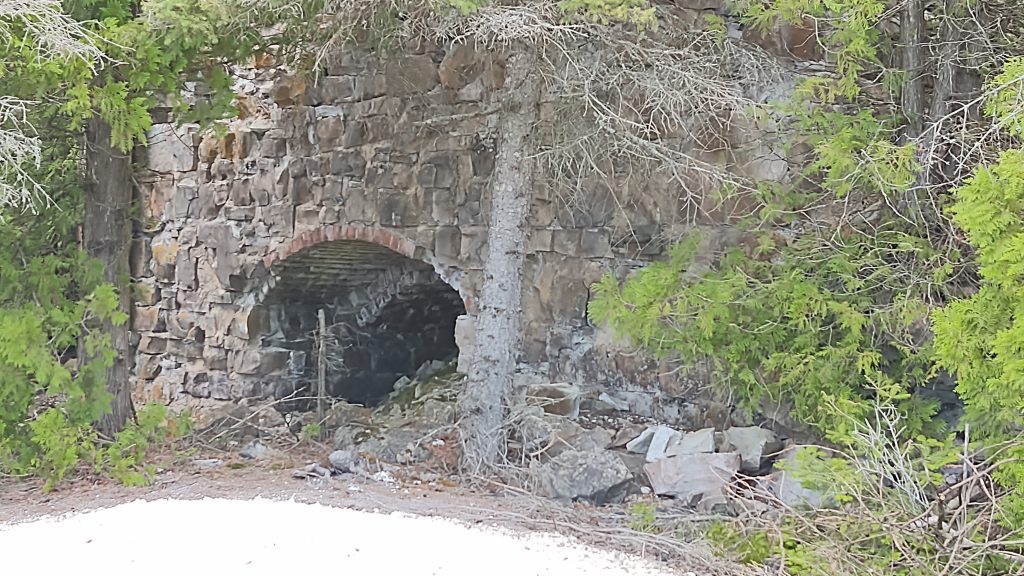
This is one of sixteen lime kilns discovered in the 1790’s.
Sixteen lime kilns were uncovered in the 1790’s. This discovery proved that the processing of lime into a strong mortar had been an important resource and driving force in the 1700’s economy. The men from Fort St. Joseph, located on a Canadian island to the northeast, used this natural resource as a construction material for their fort.
Ownership of Lime Island Has Changed Many Times
The Native tribes relinquished much of the land in the upper peninsula, including Lime Island, to the United States government in the 1836 Treaty of Washington. In 1837 Michigan was granted statehood.
Later, in 1842 Lime Island became a demarcation for the boundary line between the US and Canada. This was called the Webster-Ashburton Treaty.
Joseph Kemp
Joseph Kemp acquired Lime Island in 1848. President Fillmore had signed the deed. Joseph Kemp owned the island for 37 years. He grew hay, wheat and potatoes. He was known for building trust with the natives and trading with them. While still owning Lime Island, Kemp had moved to Ste. St. Marie from 1853-1878. He returned to his island home in 1878 and lived there until he decided to sell it to “Lime Island Manufacturing” in 1885 for $5,200.00. Barrels of lime were sold as a valuable construction material.
Lime Island Manufacturing
The visionary and retired Navy man, Frances Davenport, stepped into ownership in 1890. He built a 30 room hotel with a two story cook house off to the side. After all, Mackinac Island’s Grand Hotel to the north had opened three years before and had proven to be a smashing success!
Mae West, the movie star, was said to have stayed at Davenport’s hotel on Lime Island. Unfortunately though, this resort never gained nearly the same notoriety that The Grand Hotel had achieved.
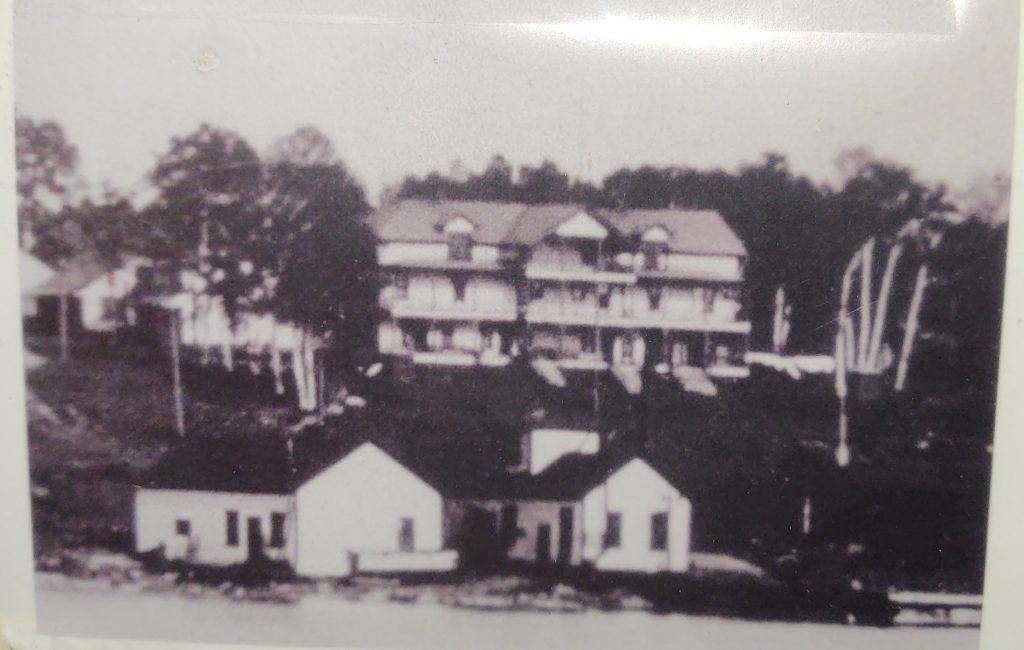
Davenport’s hotel sat on the hill behind the two boathouses. This is where the cabins stand today.
Photo Credit: Lime Island Museum
Pittsburg Coal Company
Twenty years later (1910) the ownership changed to the Pittsburg Coal Company. An enormous coal dock was built. There was a need to refuel steam ships with coal at this nearly halfway point between Chicago/ Detroit/ Duluth.
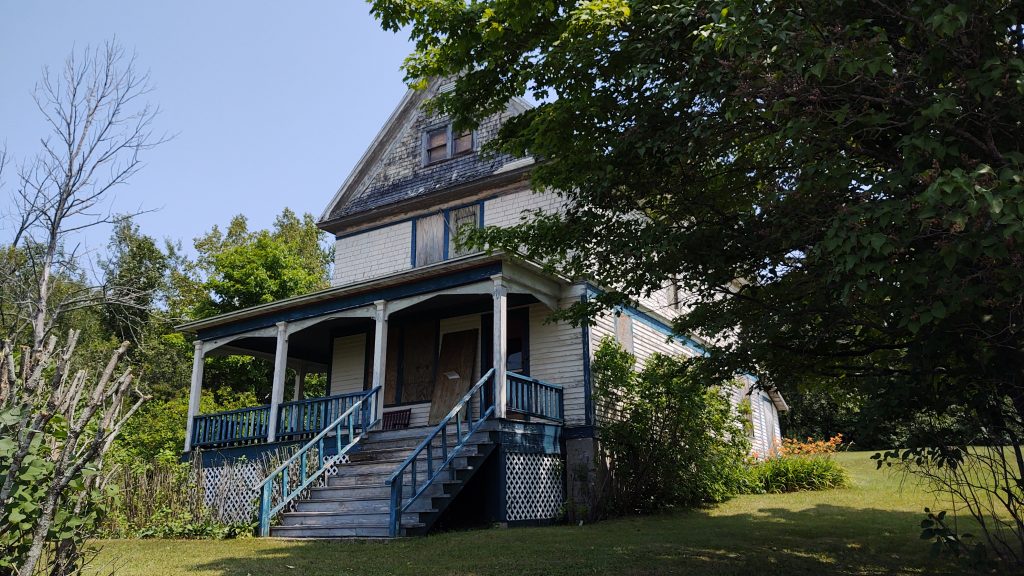
Alfred Newton, the first superintendent of the Pittsburg Coal Company, had this house “delivered.” A team of horses slid this Victorian home across the ice from Pte. Aux Fienes in Canada. Other small homes were brought over the ice as well.
Then they used the horses and a pulley system to place the buildings on pre-made foundations. (I paused to think of my own slow pace when I came up the hill and I wasn’t pulling a house or even carrying gear.)
“The Big House” Constructed
Next “The Big House” was constructed. (1910) This brick building served as a dormitory for workers who were on duty. There were bunks, a kitchen and showers. Unfortunately, with this building securely locked we were unable to give you a peek inside.
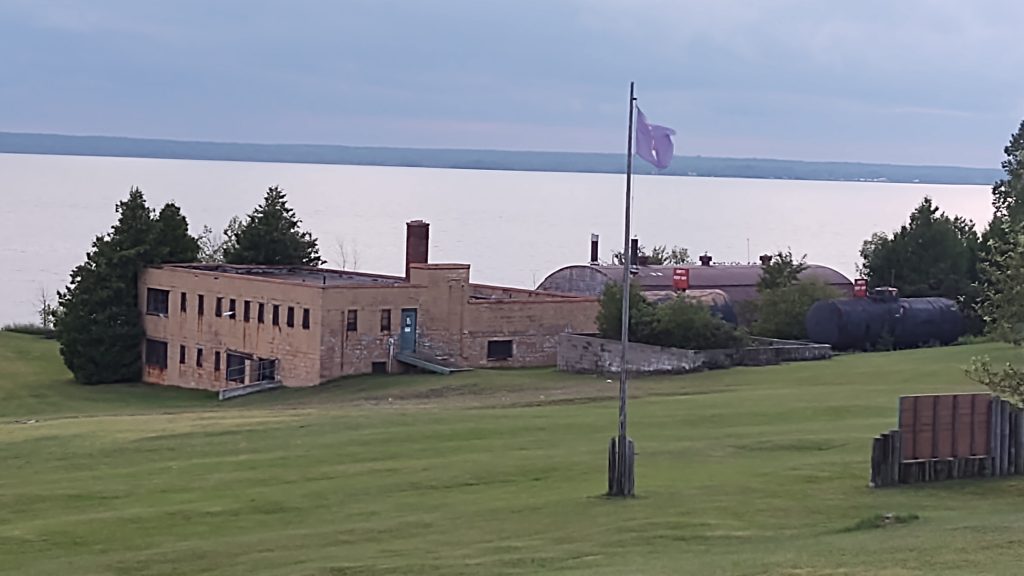
The brick building stood ready with workers to greet the ships that travel by day and night.
It amazed me to learn that the Lime Island community grew to nearly 200 people in the early 1900’s. Each homestead had a small garden, chicken coop and apple trees.
The One Room Schoolhouse
A school house was added to the small neighborhood in 1912. Anna Ballem taught the first class of K-8th graders in 1913. The building served the entire community as a meeting place, church and a barber shop.
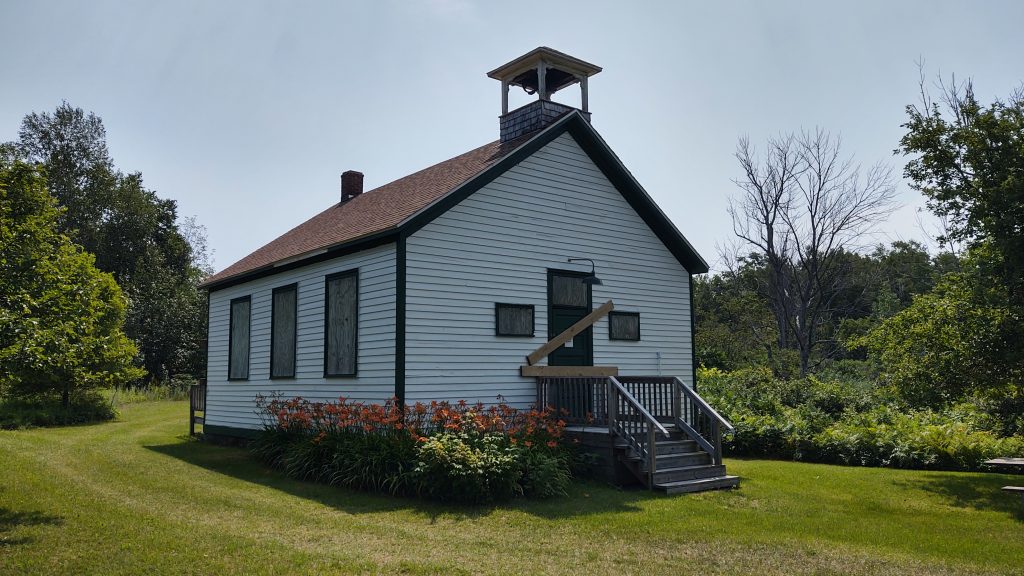
By 1928 the community grew to fourteen families living on the island. The school served their seventeen children.
According to Norma Mieras, a caretaker of the island who compiled island history, there wasn’t a specific denomination for religious gatherings. “Everyone would come together when a minister came to the island.”
The school closed in 1961. Children had to be transported to Raber (on the mainland) and then bussed to attend a school in the nearby towns. (DeTour, Pickford, Goetzville or Sault Ste. Marie) Now that’s quite a commute for a child! Some youngsters would live on the mainland with relatives or friends during the winter.
1918 Flu Epidemic
As I sat alone in the dark Victorian house which now serves as an island museum I held my flashlight over the faded pages. I read William W. Cruickshank’s words.
“In the beginning of the flu pandemic of 1918 the dock would be sanitized after each ship had left port. Then sick sailors were falling down while trying to secure lines, so islanders went to help. Soon after illness overtook the island.” William W. Cruickshank told his son Raymond in the 1950’s. Raymond recorded his father’s stories.
“Only four men were able to walk around. They’d move from house to house to keep the fires burning and doing a few chores.” William recalled, “I tapped on my bedroom window to ask a passing neighbor for help.”
William remembered that they had fed their pet rabbits potato peels and sadly the whole fluffle died. William believed they had contracted the flu virus from the peels.
Both of his brothers, Marshall and Sam, had permanent heart damage (William believed from having the flu) and died of sudden cardiac arrest in their mid 40’s.
These vivid recollections about William’s childhood have made a lasting impression with me. Imagining the whole island being crippled by a virus draws to mind parallels of other plagues throughout history and today.
Mulberry Tree
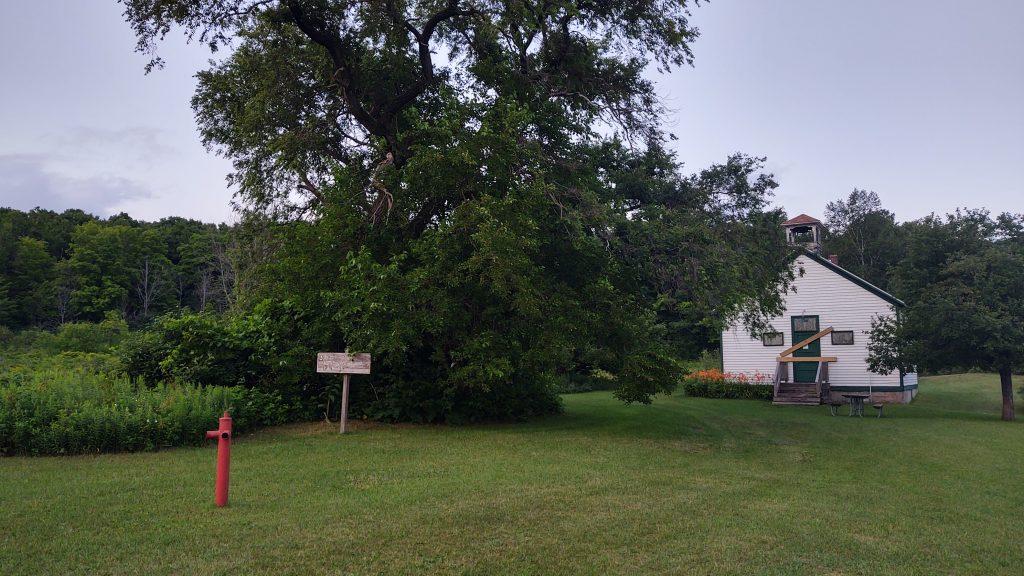
Mulberry trees are a rare find!
Near the school house grows a large mulberry tree. The fruit is sweet and holds a rich lavender color for dying textiles as well as one’s fingers. I enjoyed mulberries each day in my cold oatmeal and as a dessert.

Coal Refueling Dock
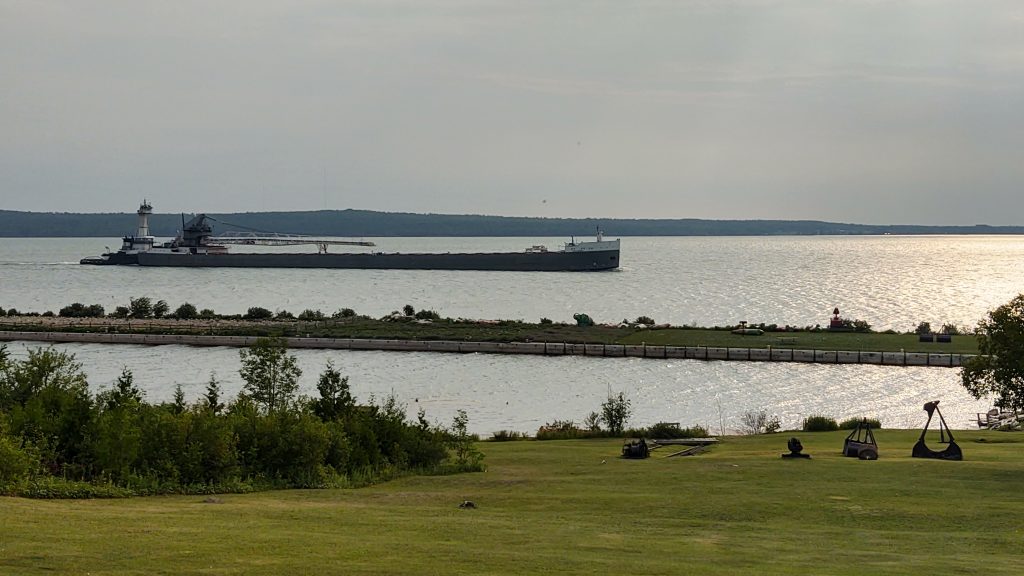
Freighters could line up along this dock for quick refueling.
In 1937 the Pittsburg Coal Company updated the coal refueling dock under superintendent, Percy Elliott.
The far side of the dock is now a protected nesting area for terns. However, the seagulls have dominated much of this area.
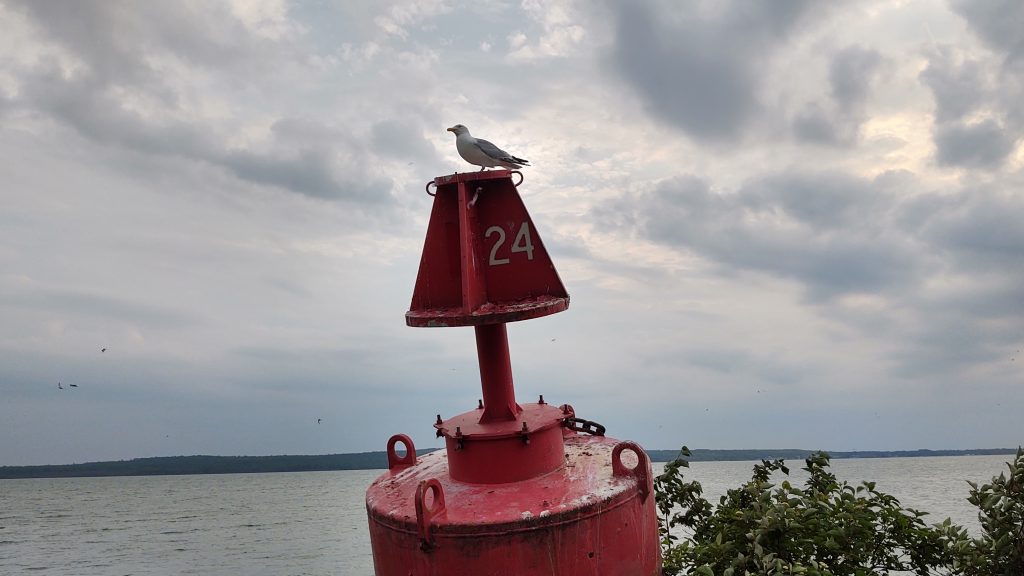
As we walked onto the coal dock, one seagull, perched on an abandoned buoy, repeatedly announced our arrival. Each bird chattered endlessly, paying no attention to the “emcee.” The noise was deafening!
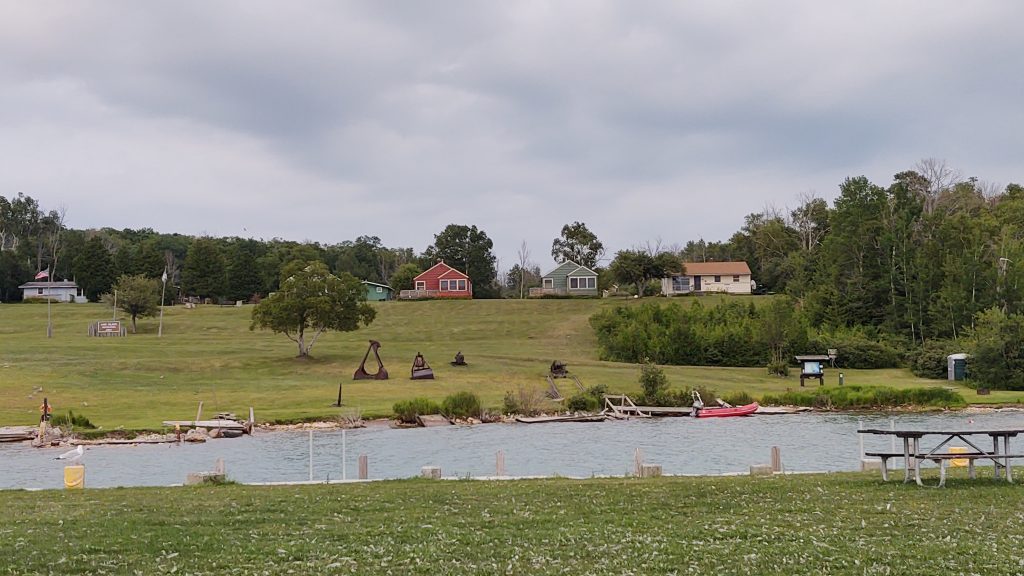
This is the view from the coal dock. Presently it provides tie ups for island visitors. You can spy Thor at his unique slip.
A Partnership
In 1948 the Pittsburg Coal Company combined with Northwest Hanna Coal Company. James Fulton took the leadership position as superintendent after Elliott’s resignation. The hotel was torn down and cabins were built. A new conveyer and coal hopper were constructed in 1951. Lime Island, “the gas station for freighters,” could refuel a ship in just 20 minutes!
Fuel Tanks
Thick “Number 6” oil had to be kept warm so two 1,750,000 gallon, insulated fuel bunker tanks were constructed in 1952.
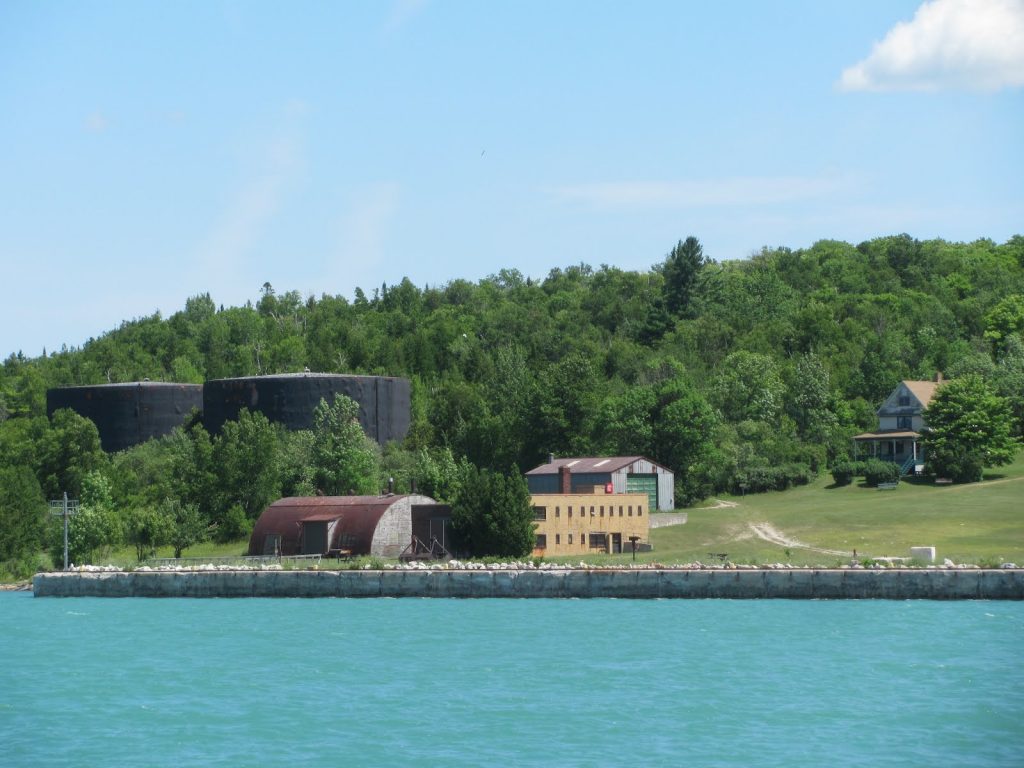
The two insulated fuel oil tanks held precious “Number 6” fuel.
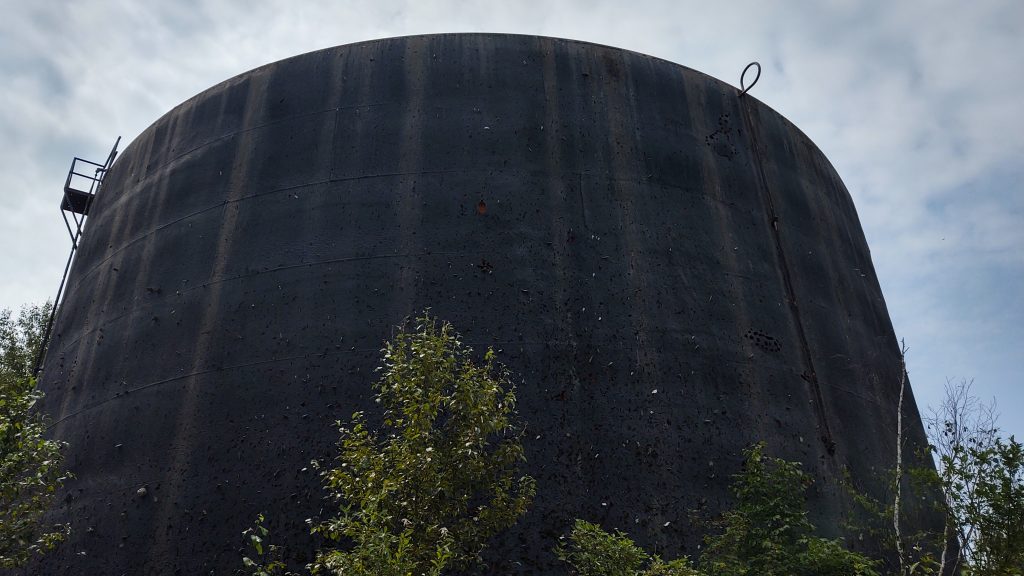
People have hurled lime stone rocks into the tank’s insulation where they have stayed permanently mounted.
Merging of Northwest and Consolidated
Northwest Hanna and Consolidated Coal Company merged in 1965. Grouting the coal dock was a priority as it was crumbling after decades of use. Engineers were transported daily on a small ice boat during these operations in 1968, 1970 and 1979.
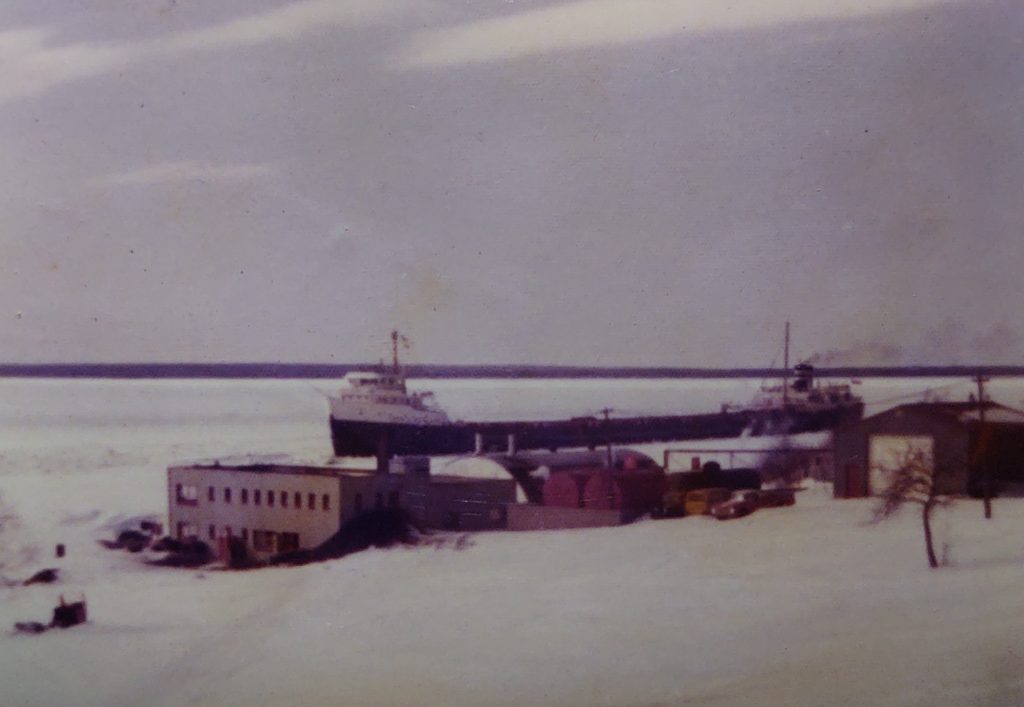
A ship was pulling up to Lime Island for refueling in the 1960’s.
Photo Credit: Lime Island Museum
Refueling Dock Closed
In the 1970’s vessels were being built larger and didn’t need to be refueled as often. In 1981 Lime Island was put up for sale. James Fulton, Superintendent 1949-1979, offered $300,000 to Consolidated Coal Company to purchase his long time, island home. Curiously however, Lime Island was sold to the State of Michigan for $1.00.
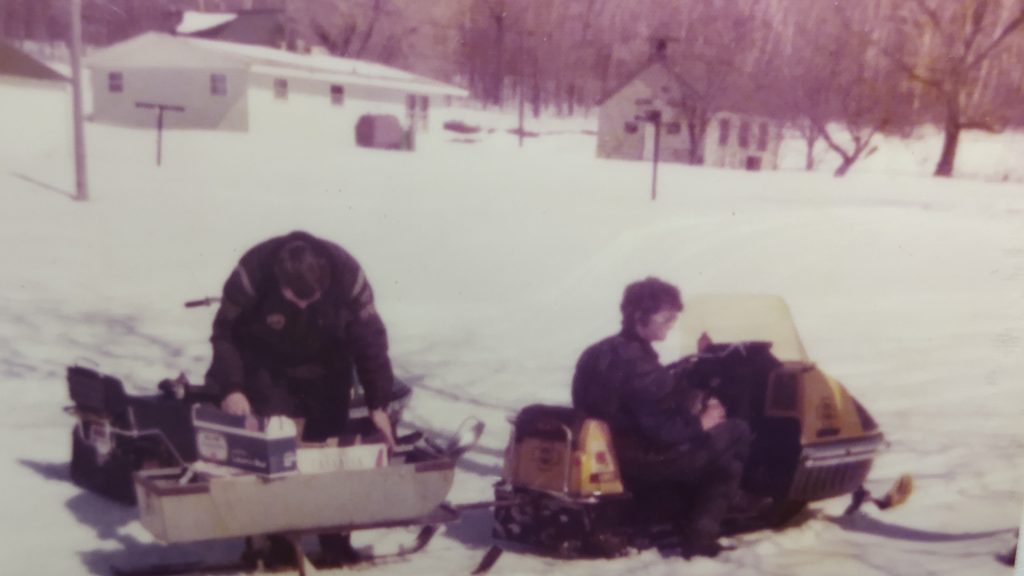
Islanders – Late 1970’s
Photo Credit: Lime Island Museum
Residents were forced to leave their homes. Many expressed their sadness over having to move back to the mainland.
Purchased in 1982 Lime Island was managed by the state’s Forest Management Division. Vandals spray painted the cabins and left trash all over the island. Funding was a struggle and at meetings there was talk of shutting down the island completely.
Restoration
Still under the Forest Management Division, along with volunteers, the school house restoration began in 1992. By 1993 the group had achieved an official registration with Historic Places. Several annual open houses were held (’94, ’95, ’96) to create interest and build financial support for further improvements to the island. Repainting of the Victorian home took place in 1996 along with remodeling the cabins.
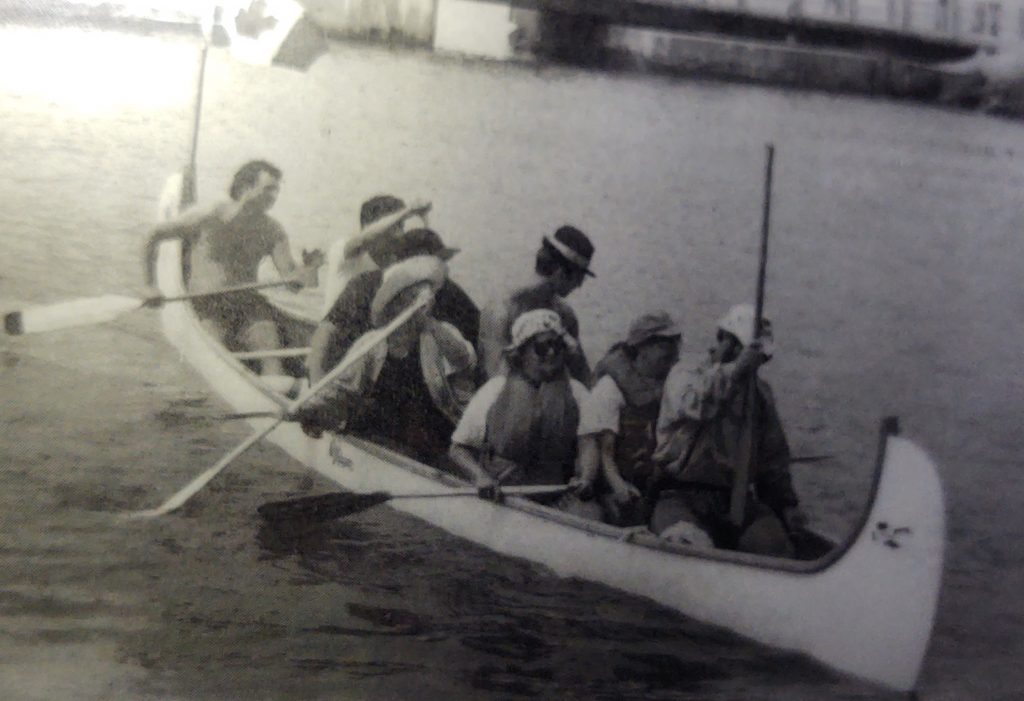
Photo Credit: Lime Island Museum
Around 2003 Chuck’s Fortune Bay Expedition group had been kayaking the St. Mary’s River as a storm was kicking up. They pulled off at Lime Island. Janet and Howard, the caretakers, surprised the group as expedition hadn’t realized the island was inhabited. Janet and Howard rented the adventurers a cabin as refuge until the bad weather passed.
By 2004 a Master Plan had been developed by the Michigan Department of Natural Resources. Their report included prioritizing needed renovations. Caretakers living on the island managed volunteers doing the work.
In 2011 Lime Island was transferred to the Parks Department and it became the 99th park unit. Lime Island is the newest state park and I’d say the most unique.
Research
A group from Michigan State University came to study the tern population. (1997) They have protected nesting grounds on the refueling dock. The terns and seagulls made a constant chatter at all hours, around the clock, every day!
Betsy Cook worked on her master’s degree by studying the shipwreck, Rome. On November 17, 1909 the Rome caught on fire near Lime Island’s shoreline. All crew members survived. The rubble was left and became a break wall.
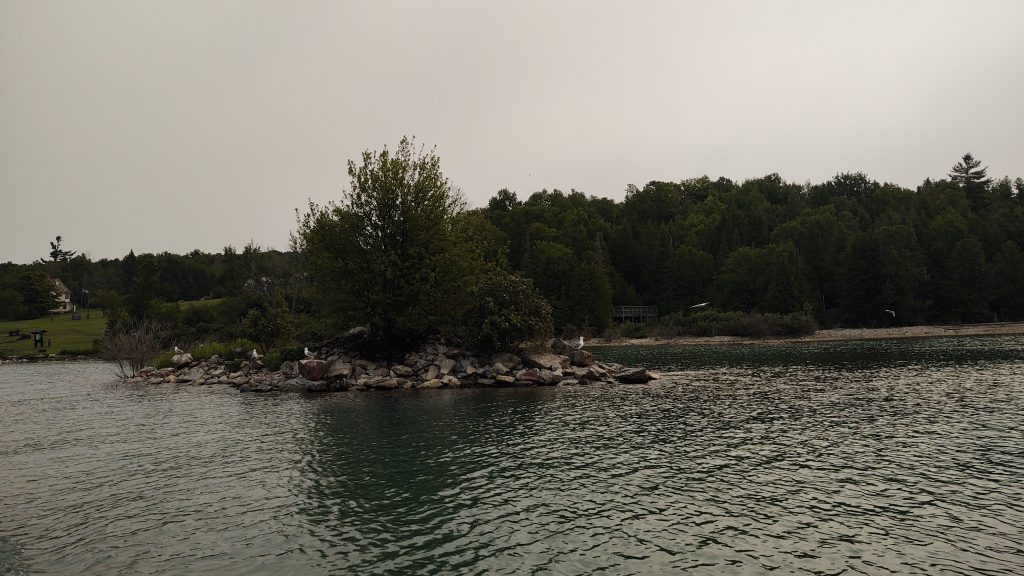
The Rome shipwreck from 1909 has remained as a break wall and can be viewed today.
On the far left one can spy the Victorian home/museum.
Freighters
Lime Island’s entertainment is unlike any other place I’ve seen! Freighters slide by day and night. When Janet and Howard were caretakers in 2006 they’d rush outside and heartily wave at each ship. Janet would announce the name of the captain and encourage our kids, Charlotte and Noah, to join in the full arm greeting. We were all giddy when the captains would sound their horns as a friendly, “Hello!”
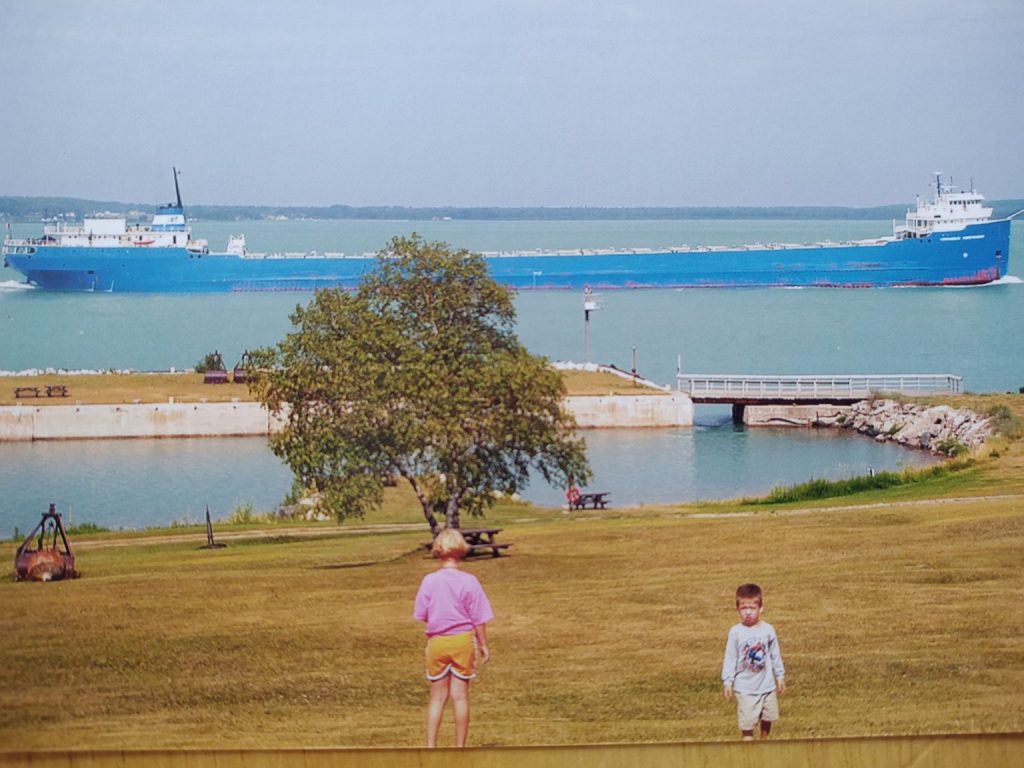
Charlotte and Noah take a break from catching grasshoppers to view the passing freighter. Four year old Noah turned to tell us another ship was going by.
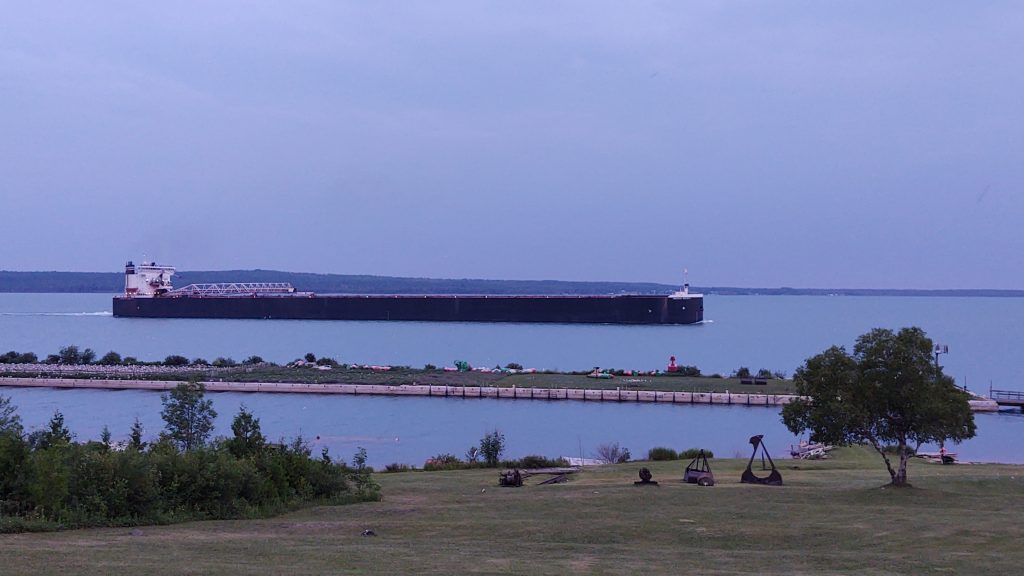
As sunlight faded and clouds covered the sky another vessel glided passed us.
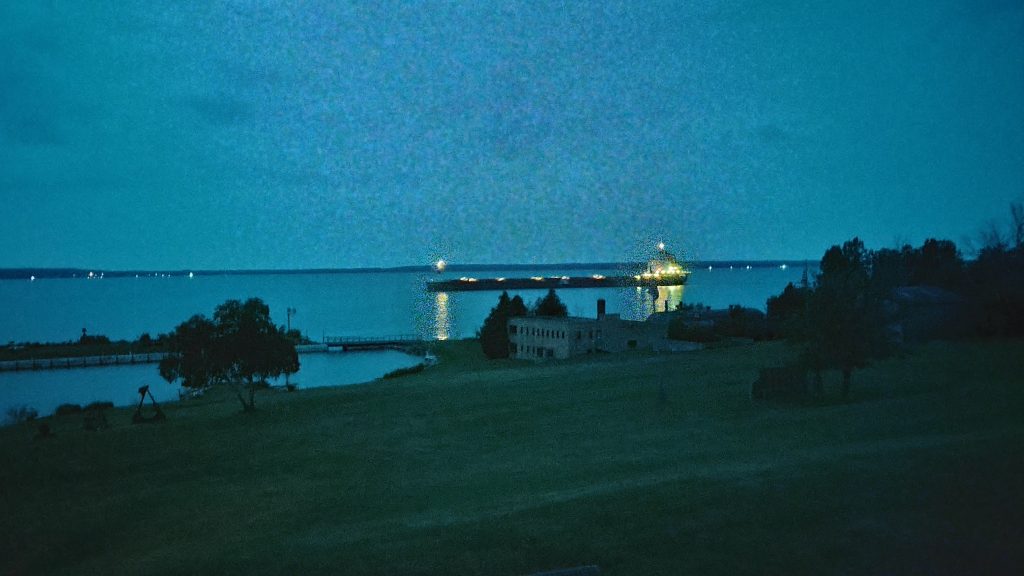
The lights on this ship gave me a holiday feeling on the warm July night.
Saturday
The morning greeted us with a blanket of fog. It was peaceful, damp and chilly.
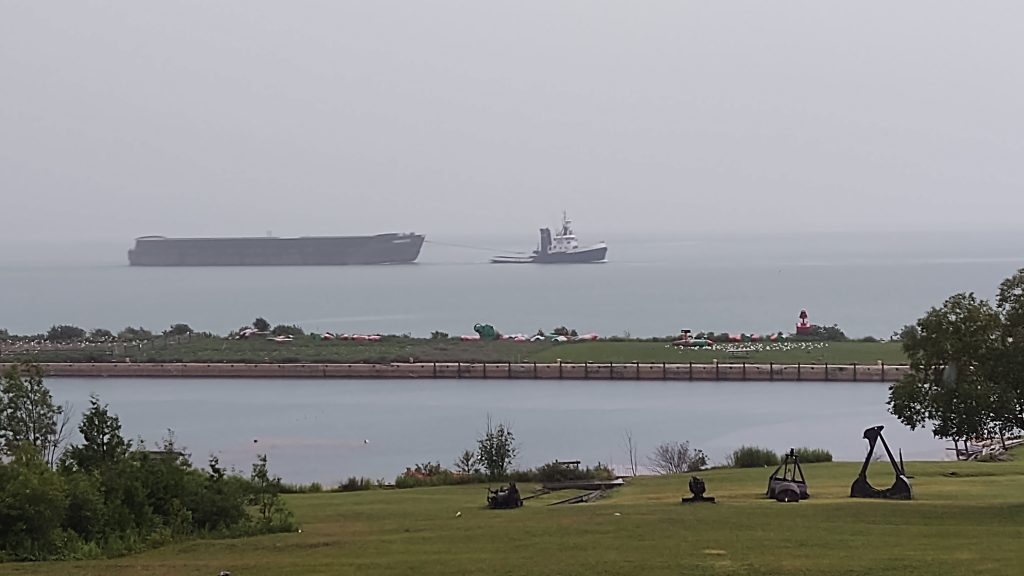
This little tug reminded me of a children’s book.
We decided to cruise around the island in Thor. We wondered what we’d find on this misty morning.
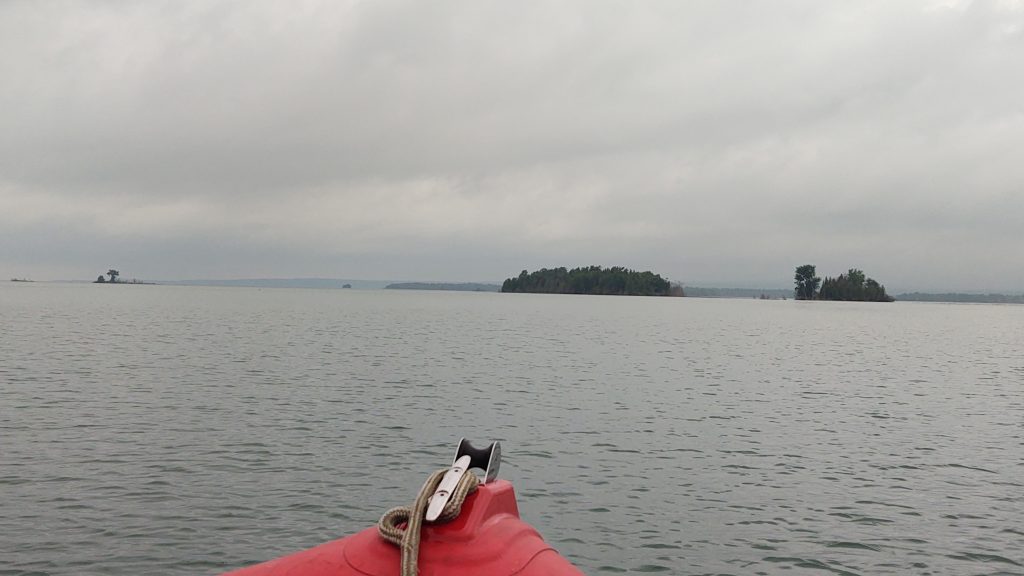
Islands dotted the waterway along the eastern shoreline. Canadian waters were to the right and United States property was on the left.
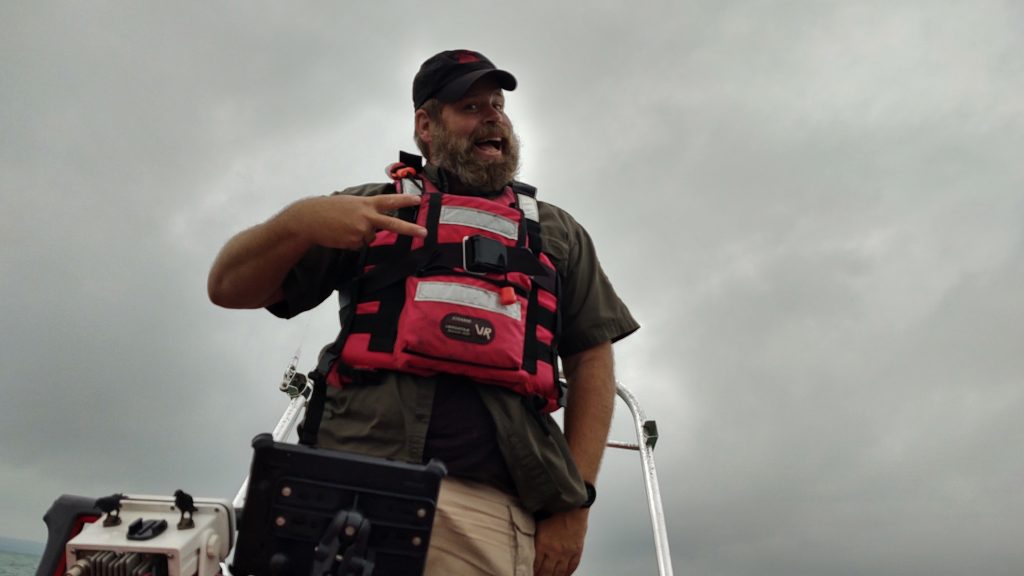
Da Viking makes everything FUN!
As we looped over the northern tip of Lime Island, a freighter came into view. I think I was giggling like a kid when I told Chuck, “I’ve never been this close to a freighter!” Da Viking made sure it was a memorable meeting.
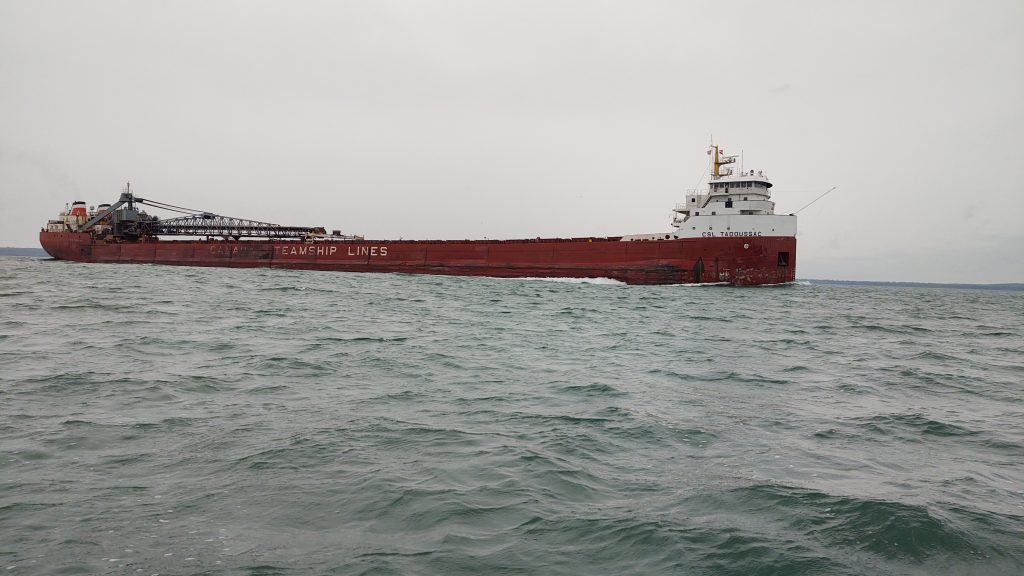
He scaled close to the ship and we rode the wake. The billowing waves rose five feet tall. I squealed as if I was riding a roller coaster!
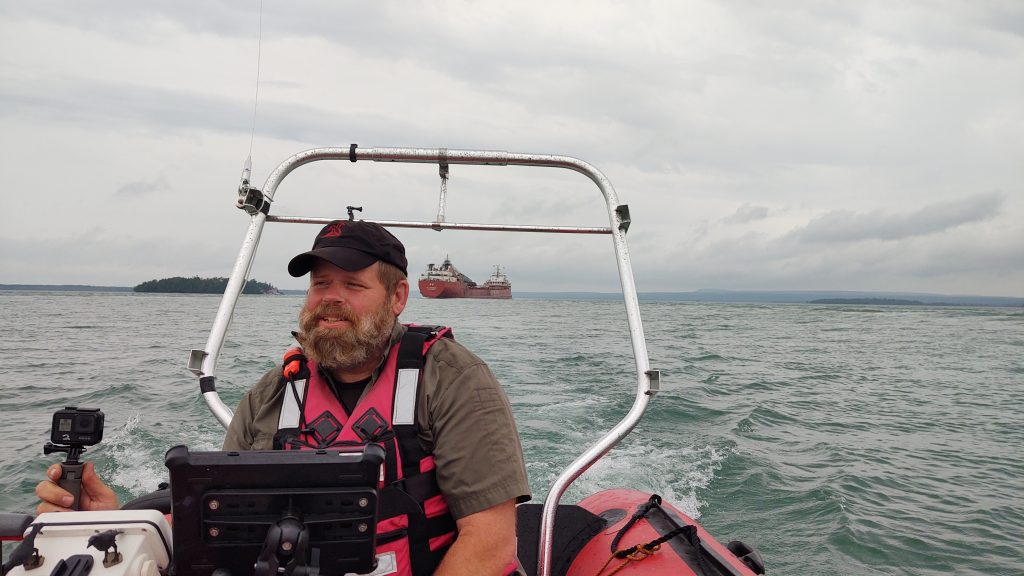
Da Viking was proud of his piloting skills. Riding the five foot wake mimicked a rollercoaster ride!
Sunday’s Departure
As we cleaned the cabin and loaded our gear into Thor, I felt a connection to the people who have lived on Lime Island. I held a better appreciation for their hearty grit as they survived on a distant dot of land.
Suddenly we heard, “Hey, Poppins! Da Viking! It’s you!” a man pulled up in his boat. “Hello!” I called and searched my ‘rusty rolodex’ in my brain trying to place who he was. As a retired teacher, I often have people approach me and it takes me some time to place who they are.
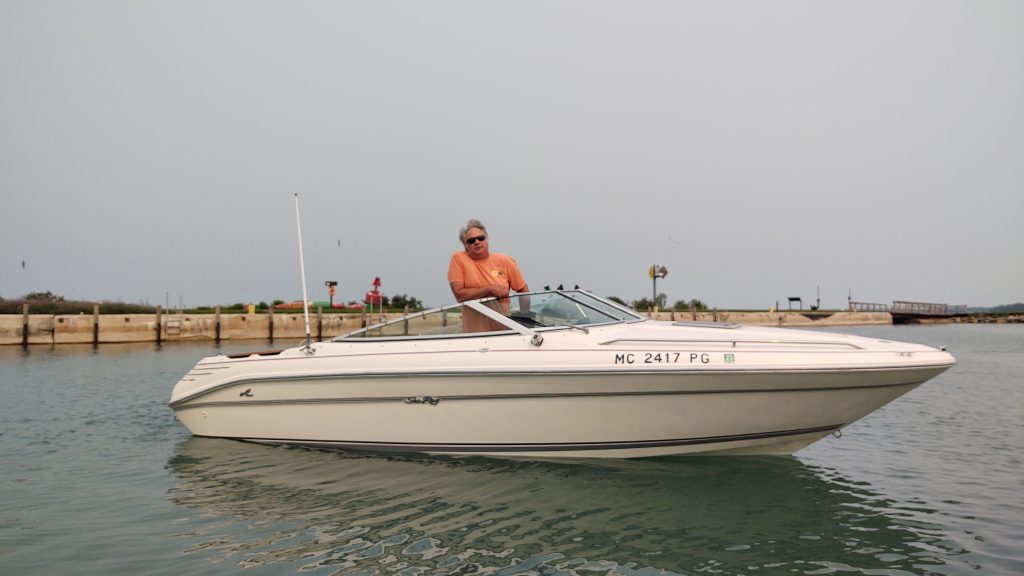
“RevKev” pulled up to wish us well!
“I saw on Facebook that you were on Lime Island and I was hoping to meet you!” He called from his boat. “I’m Kevin.” He introduced himself. I realized this was someone from our new chapter of life. After a pause of realization, we called back to our fan. “Gosh. it’s great to meet you!” He explained that he was on his way from DeTour to the Sault Ste. Marie and stopped by hoping to meet us.
Speaking of connections, it was GREAT to meet Kevin! Chuck and I want to inspire others to travel, embrace history, meet locals and learn their stories. It was heartwarming to have Kevin seek us out for a “Hello!”
Chuck and Martha Hayden, aka The Viking and Poppins, enjoy going on adventures off the beaten path. They also like to share their explorations with others. The Viking is a retired expedition leader while Poppins is a retired teacher. The two offer independent views of their journeys showcasing places, people, and cultures as they explore the world. Visit and follow them on their website and social media accounts. Website | Facebook | Instagram |YouTube


My father worked on Lime Island for 18 years, retiring in 1976. I remember it well and your history is quite accurate.